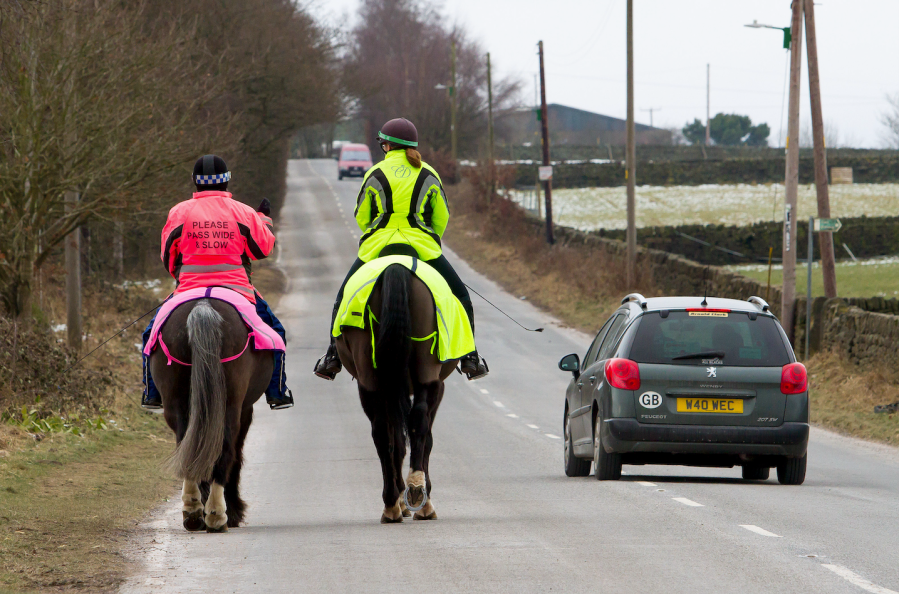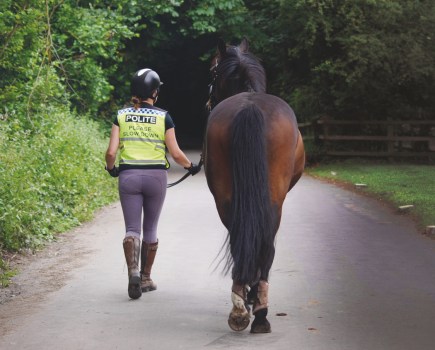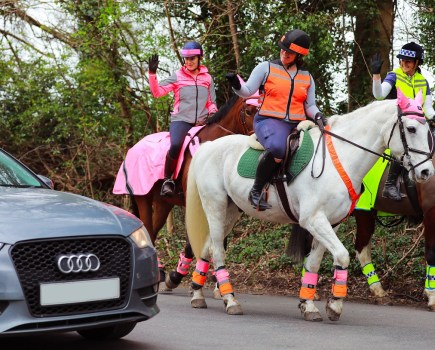Sooner or later, most of us end up riding a horse on the road when we are out hacking. I mostly ride on country lanes, but there is a busy A road that I have to cross to get to several local bridleways. I’ve always hacked out on the road, even as a child, and for the most part I enjoy it. However, since moving to Oxfordshire and being faced with HS2 lorries flying past me and my Thoroughbred (who thankfully is 100% traffic proof), I’ve become more aware of road safety for horse riders than ever before.
My pony was hit by a car when I was 10 — she was uninjured, thankfully — and my life once flashed before my eyes (it really did) when my usually bombproof Thoroughbred leapt into the middle of the main road in front of a fully loaded cattle lorry. The farmer at the wheel was driving far too fast to have any chance of stopping.
My horse was spooked by the sound of the poor cattle on board struggling to stay on their feet as the lorry came hurtling around the bend towards us. His flight instinct kicked in and he leapt in the air, spinning around to turn for home, leaving us very close to the middle of the road. That farmer missed us by inches.
There is a real lack of off-road riding in some parts of England. In Scotland, its ‘Freedom to Roam’ act means horse riders can cross private land. In other countries like the USA and Australia, where there is just a lot more space in general, it’s different too. I spent five days’ hacking in Hungary a few years ago, and I can’t recall having to ride on a single road. Bliss!
Horse rider road safety: things you can do
The 2022 updates to the UK’s Highway Code place horse riders above drivers in its hierarchy of road users (find out more about what that means here). However, it is still in our interest, as horse riders and therefore vulnerable road users, to do all that we can to stay safe on the road.
“My mission as a police officer and equestrian is to build tolerance and understanding between car drivers and horse riders,” says Sgt Zoe Billings of North Yorkshire Police, who regularly gives talks on road safety and cooperation between drivers and riders. “Most of us fall into both camps, but when we’re on the road with our much-loved hay burner, we tend to see everything from just the rider’s perspective.
“If we, as horse riders, sometimes feel aggrieved when we’re driving, imagine how folk with no affinity for our mobile mowers feel. It doesn’t take much to give a negative opinion, so, for the sake of all our safety, thank all drivers to encourage desired behaviour.
“Put your hand up (if you feel secure enough), smile and give a big nod. Thank all drivers, including those who perhaps could have done more — but not those who are driving dangerously, of course.”
BHS advice
According to statistics released by the British Horse Society (BHS), nearly two horses a week are killed on UK roads. They make three main recommendations to help improve the safety of riders on the road:
- Reduce and enforce speed limits on roads where horses are ridden regularly.
- Riders should wear lights when riding, in a pattern that highlights their width (two red LEDs on the rider’s shoulders and two on the horse’s flanks facing traffic coming from behind. White LED’s facing forward in a similar pattern to alert approaching traffic)
- Riders should wear reflective high-vis clothing, especially in the absence of lights. Bear in mind the colours of the area you’re riding in (eg, dark green hedge lines) and the time of day (eg, bright sunshine) and choose contrasting colours accordingly.
Road safety: things horse riders can do
- Thank drivers who pass wide and slow — if you do, they’re more likely to do the same for the next horse they see.
- When riding on a narrow road, get out of the way as quickly as you can. For example, trot to the nearest gateway or move on to the verge, if it’s safe to do so.
- Ride single file when you’re on a narrow, winding road so there’s more room for approaching vehicles to go around you.
- Don’t react to any abuse an impatient or rude driver may throw your way.
- If possible, ride at quieter times of the day and avoid peak commuting times.
- If you’re on a young or nervous horse, don’t ride them on the road on your own.
- Give drivers every opportunity to see you by kitting out both you and your horse with lights and high-vis clothing. A solicitor warns that not wearing high vis could leave you liable in the event of an accident.
- Ensure you have public liability and personal accident insurance cover in place.
- Avoid riding in the dark/poor light.
- Give the road your full attention: don’t use your mobile phone or listen to music, and limit chat.
- Desensitise your horse to traffic as far as you can. For example, if you’re worried about tractors, work regularly in a field or arena with a tractor nearby.
- Always tell someone where you’re going to ride and give an estimated time of return. Consider using an app like Horse Rider SOS, which monitors your movements. In the event of a fall the app will enter “Alert mode’ and kick off a rescue process.
Report every incident
Operation Snap is a marvellous opportunity for horse riders and other vulnerable road users. It is a streamlined way to report every incident or near miss you experience (this includes run ins with loose dogs and other issues, as well as traffic concerns) to the police.
Invest in a hat cam (and make sure you wear it for every hack) and report every single thing you incident via Operation Snap and also to the BHS.
If nobody knows about incidents involving horses and riders on the road, nothing can be done to combat the problem. The BHS has assisted in mounted police patrols of roads that are particular hot spots for horse riding incidents, and these were only made possible as a result of data obtained from incidents reported by riders like us.
I believe that everyone who rides horses has a duty to wear a camera out hacking and report every incident we experience to the police and the BHS.
Spread the message of pass wide and slow to everyone you know. Share social media posts about horses and riders being injured and killed on the road on so that your non-horsey friends see it.
Make them aware of the consequences their actions could have. Ultimately, there is a long way to go to make roads safer for horse riding. We need to stand together to try and make it happen.
The driver’s perspective
If you scroll through the comments on social media posts about horses being ridden on the road, it won’t be long before you come across a driver’s opinion and the resulting debate is usually heated. Education is key, but what about those drivers who won’t listen?
A study by Chapman and Musselwhite in 2011 examined the attitudes and reported behaviour of drivers and riders through focus groups. Topics discussed included risk perception, emotion, attitudes to sharing the road and empathy.
As well as highlighting the need to address drivers’ lack of knowledge and skills when passing horse riders, the study found that a rider’s clothing and use of safety equipment influenced drivers’ behaviour too. Drivers acknowledged that a judgement is made regarding how much control a rider has over their horse, but this is often over-estimated. See the full study here.
More recently, a focus group-based study (Scofield, Savin & Randle, 2016) found there was no significant difference between response times for a fluorescent tabard and a black/white tabard. However, there was a big difference in response times for both tabards compared to a dark colour. It concluded that a rider’s choice of clothing is important.
When I surveyed Your Horse’s #Hack1000Miles challengers in 2019 and asked their thoughts on horse rider road safety, nearly 25% said they had been involved in an accident while riding on the road.
Take the BHS Ride Safe Award
More than 4,000 horse riders take the BHS Ride Safe Award each year and while it’s not essential, it is sensible. In the meantime, test your knowledge about horse rider road safety with the following questions from the BHS. Answers at the bottom of the page.
Question 1
On which side of the road should you ride?
a) On the same side as the traffic
b) On the opposite side, so that traffic comes towards you
c) It doesn’t matter
Question 2
How should you tell drivers you are turning off a road?
a) Before turning, look behind to make sure it’s safe and then give a clear arm signal
b) Just make the turn
c) Ride into the middle of the road, forcing drivers to stop
Question 3
Up to how many horses can be ridden side by side on the road?
a) One — single file
b) Two abreast
c) It depends on each horse’s experience
Question 4
How many horses does the BHS recommend limiting group numbers to when riding on the road?
a) 5
b) 8
c) 12
Question 5
When approaching a stationary vehicle, what do you need to consider when passing it?
a) Leave enough room in case the door suddenly opens
b) Look behind in good time to ensure it’s safe for you to move out into the road and pass
c) Be mindful of pedestrians and sudden noises from inside the car
d) All of the above
Question 6
Who should you report an unsafe or unusable gate on a bridleway to in the UK?
a) Your local council
b) The police
c) The BHS
Question 7
When riding across agricultural land, how should you leave a gate?
a) Closed
b) Open
c) As you find it
Question 8
Who must wear a riding hat when on the road, as per UK law?
a) Children under the age of 14
b) Everyone
c) No one — it’s up to the individual
Question 9
What’s the first thing you should do if an accident happens?
a) Panic
b) Ride away
c) Make the situation safe
Question 10
How should you navigate a roundabout on horseback?
a) Avoid them — horses aren’t allowed on roundabouts
b) Keep left, on the outside of the roundabout, regardless of which exit you’re taking
c) Treat roundabouts the same way you would when driving a car
Horse rider road safety: the future
There’s a lot of work to be done towards making roads safer for horses, but following the above advice and spreading the word about the updated Highway Code will help.
The BHS’s Dead or Dead Slow? campaign is aimed at educating drivers and there are regular ‘Pass Wide & Slow’ mounted ride campaigns around the country every year which riders can participate in.
Main image: copyright Shutterstock
Related content
- Operation Snap: how and why more riders need to use it
- Why wearing the colour red could play a part in safer hacking
- Alan Hiscox: educating learner drivers to pass horses safely is key
- How to report an incident to the BHS
- Number of loose dogs attacking horses is on the rise
Quiz answers
Q1. Correct answer: a) In the UK, all road traffic should be on the left, including horses
Q2. Correct answer: a) Before turning, look behind to make sure it’s safe and then give a clear arm signal. When you’re sure all drivers have understood, make your turn.
Q3. Correct answer: b) Never ride more than two horses abreast, putting the more experienced horse on the outside. Ride in single file on narrow or busy roads, and when riding around bends.
Q4. Correct answer: b) Always make sure group sizes are sensible, ideally no more than eight riders, for safety and practicality reasons.
Q5. Correct answer: d) All of the above. Stay alert, think ahead and move back to the left-hand side of the road as soon as you are clear of the vehicle.
Q6. Correct answer: a) Your local council. Find their contact details here.
Q7. Correct answer: c) Always leave a gate how you found it.
Q8. Correct answer: a) Only children under the age of 14 are required by law to wear a riding helmet that is securely fastened. Your Horse advises everyone to wear a hat when mounted. After all, you only have one head and hats are easier to replace.
Q9. Correct answer: c) Make the situation safe. If you can, send someone to warn approaching traffic to slow down and try to catch any loose horses. Dial 999 on a mobile phone.
Q10. Correct answer: b) Keep left. Watch out for vehicles crossing your path to leave or join the roundabout. Signal right to show you are not leaving at an exit and signal left just before exiting. If it’s a big roundabout with traffic lights, remember red lights apply to horse riders and so you must stop too.










